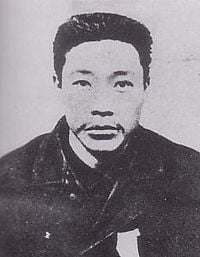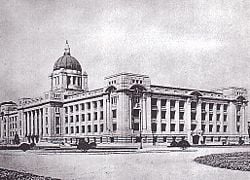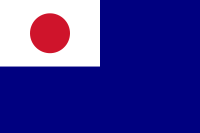Difference between revisions of "An Jung-geun" - New World Encyclopedia
Anne Inoue (talk | contribs) (early life) |
Anne Inoue (talk | contribs) (second section) |
||
| Line 11: | Line 11: | ||
==Early life== | ==Early life== | ||
| − | An Jung-Geun was born in [[Haeju]], [[Hwanghae]] Do, now part of North Korea, to a family of the [[Sunheung]] An lineage. He was educated at a local Seodang for nine years, studying Chinese classic literature and neo-confucian thinking. In his late teenage years, he became interested in the Catholic faith, and was baptised as a Catholic on January 10, 1897, receiving the baptismal name Thomas. He began working as a missionary | + | An Jung-Geun was born in [[Haeju]], [[Hwanghae]] Do, now part of North Korea, to a family of the [[Sunheung]] An lineage. He was educated at a local Seodang for nine years, studying Chinese classic literature and neo-confucian thinking. In his late teenage years, he became interested in the Catholic faith, and was baptised as a Catholic on January 10, 1897, receiving the baptismal name Thomas. He began working as a Catholic missionary, and studied with the foreign Catholic missionaries serving in the region. |
| + | |||
| + | In 1906, Ah was instrumental in founding two schools in South Pyeongan province, the Samheung School and the Donghee School, and served as principal of both schools. Like many Christians in late Joseon Korea, he became active in the Korean independence movement,protesting against the increasing control that Japan was leveling over Korea. | ||
| + | |||
| + | ==Active work for independence== | ||
| − | |||
He worked first in education, later joining the armed resistance against the Japanese colonial rulers. While fleeing the fighting he took refuge with a [[priest]] of the [[Catholic_Church|Roman Catholic Church]] named Wilhelm (Korean name, Hong Sok-ku) and hid in his church for several months. The priest encouraged An to read the Bible and after a series of discussions with Wilhelm, An converted to [[Catholicism]] in January 1879. He maintained his belief in Catholicism until his death, even asking his that his son become a priest in his last letter to his wife.<ref name=keene>Emperor of Japan: Meiji and His World, 1852–1912 by Donald Keene, Columbia University Press, 2002. ISBN 0-231-12340-X</ref> | He worked first in education, later joining the armed resistance against the Japanese colonial rulers. While fleeing the fighting he took refuge with a [[priest]] of the [[Catholic_Church|Roman Catholic Church]] named Wilhelm (Korean name, Hong Sok-ku) and hid in his church for several months. The priest encouraged An to read the Bible and after a series of discussions with Wilhelm, An converted to [[Catholicism]] in January 1879. He maintained his belief in Catholicism until his death, even asking his that his son become a priest in his last letter to his wife.<ref name=keene>Emperor of Japan: Meiji and His World, 1852–1912 by Donald Keene, Columbia University Press, 2002. ISBN 0-231-12340-X</ref> | ||
Revision as of 15:23, 13 May 2008
- This is a Korean name; the family name is An.
| An Jung-geun | ||||||||
|---|---|---|---|---|---|---|---|---|
 | ||||||||
| Korean name | ||||||||
|
Ahn Jung-Geun or An Jung-Geun (September 2, 1879 - March 26, 1910) (Baptismal name: Thomas) was a Korean independence activist, nationalist, and pan-Asianist. In 1909, during the period following the signing of the Eulsa Treaty, when Korea was a protectorate of Japan, he assassinated Itō Hirobumi, the Japanese statesman who had been appointed as Japan's first Resident-General of Korea, a post Hirobumi held from 1905 until his assassination. Ahn was arrested and held in Japanese prison after the assassination, and executed the following year, just months before Japan's annexation of Korea in August, 1910. Ahn is considered a patriotic martyr in South Korea. A small museum has been constructed to honor him, and a memorial service is held each year on the the anniversary of his death.
Early life
An Jung-Geun was born in Haeju, Hwanghae Do, now part of North Korea, to a family of the Sunheung An lineage. He was educated at a local Seodang for nine years, studying Chinese classic literature and neo-confucian thinking. In his late teenage years, he became interested in the Catholic faith, and was baptised as a Catholic on January 10, 1897, receiving the baptismal name Thomas. He began working as a Catholic missionary, and studied with the foreign Catholic missionaries serving in the region.
In 1906, Ah was instrumental in founding two schools in South Pyeongan province, the Samheung School and the Donghee School, and served as principal of both schools. Like many Christians in late Joseon Korea, he became active in the Korean independence movement,protesting against the increasing control that Japan was leveling over Korea.
Active work for independence
He worked first in education, later joining the armed resistance against the Japanese colonial rulers. While fleeing the fighting he took refuge with a priest of the Roman Catholic Church named Wilhelm (Korean name, Hong Sok-ku) and hid in his church for several months. The priest encouraged An to read the Bible and after a series of discussions with Wilhelm, An converted to Catholicism in January 1879. He maintained his belief in Catholicism until his death, even asking his that his son become a priest in his last letter to his wife.[1]
An Jung-geun assassinated Ito Hirobumi on the railway platform in Harbin, Manchuria in 1909. After firing upon Hirobumi, he is said to have knelt down to make the sign of the cross, and yelled for Korean independence and waved the Korean flag. Afterwards he was arrested by Russian guards who held him for two days before turning him over to Japanese colonial authorities. An was quoted as saying "I have ventured to commit a serious crime, offering my life for my country. This is the behavior of a noble-minded patriot."[1] Despite the orders from a Korean Bishop to not to administer the Sacraments to An, Fr. Wilhelm disobeyed and went to give An the Last Sacraments. An insisted that the captors call him by his baptismal name, Thomas.
His Japanese captors showed sympathy to An. An recorded in his autobiography that the public prosecutor, Mizobuchi Takao, exclaimed "From what you have told me, it is clear that you are a righteous man of East Asia. I can't believe a sentence of death will be imposed on a righteous man. There's nothing to worry about." He was also given New Year's delicacies and his calligraphy was highly admired and requested.[1]
Japanese colonial court sentenced him to death. An was angered at the sentence, though he expected it. He had hoped to be viewed as a prisoner of war instead of an assassin. Judge Hirashi, who presided over An's trial, had promised An that a stay of execution for at least a few months would be granted, but Tokyo ordered prompt action. An did not appeal the verdict, though he did ask for the warden's help to finish his essay, "On Peace in East Asia" and for a set of white silk Korean clothes to die in. The warden was able to grant the second request and resigned shortly afterwards. The execution by hanging took place in Port Arthur, then also known as Ryojun on March 26, 1910. Itō's death resulted in the acceleration of the final stage of the colonization process.[1]
An Jung-Geun was an admirer of Emperor Meiji of Japan. One of the 15 'charges' An leveled against Ito was that he had deceived the Emperor of Japan, whom An felt desired peace in East Asia and Korean independence. An requested that Meiji be informed of his reasons for his assassination of Ito in the hopes that if Meiji understood his reasons, the emperor would realize how mistaken Ito's policies were and would rejoice. An also felt sure that most Japanese felt similar hatred for Ito, an opinion he formed from talking with Japanese prisoners in Korea.[1]
For his actions as a resistance fighter, he was awarded South Korea's Order of Merit for National Foundation in 1962.
Pan-Asianism
An strongly believed in a union of the three great countries in East Asia, China, Korea, and Japan in order to counter and fight off the "White Peril", being the European countries engaged in colonialism, restoring peace to East Asia. He followed the progress of Japan during the Russo-Japanese War and claimed that he and his compatriots were delighted at hearing of the defeat of one of the agents of the White Peril, but was disappointed that the war ended before Russia was totally subjugated.
An felt that with the death of Itō, Japan and Korea could become friends because of the many traditions that they shared. He hoped that this friendship, along with China, would become a model for the world to follow. His thoughts on Pan-Asianism were stated in his essay, "On Peace in East Asia" that he worked on and left unfinished before his execution.[1]
In popular culture
He is commemorated in the martial art Taekwondo with the Joon Gun pattern being dedicated to him.
Novelist Bok Geo-il's 1987 novel Looking for an Epitaph (碑銘(비명)을 찾아서) is an alternate history story, which is set in the 1980's of Korea that remained a permanent colony of Japan, as a cascade effect of An's failure to assassinate Ito. The Korean movie 2009 Lost Memories is very loosely based on the novel but tells a completely different story. In the Korean film, An Jung-geun is spotted and killed by Japanese soldiers before he is able to shoot Ito Irobumi. The subsequent butterfly effect makes Japan join the allied side during WW2 and become a permanent member of the UN Security Council, enduring the Japanese occupation of Korea till the beginning of the 21st century.
In the PC game Civilization IV expansion pack, Beyond the Sword, An Jung-geun is a Great Spy.
See also
- Korean independence movement
- Korean nationalism
ReferencesISBN links support NWE through referral fees
- http://www.ndl.go.jp/site_nippon/kensei/shiryou/limage/Gazou_40_3.html "Peace of East Asia
" Thesis written by An Jung-geun in 1910]
- cite book|title=Ethnic Nationalism in Korea|first=Gi-Wook|last=Shin|publisher=Standford University Press|date=2006|isbn= 0-8047-5408-X
External links
- 2009 Lost Memories at the Internet Movie Database
- Catholic Church in Korea and the Nationalist Movement. Catholic Bishops' Conference of Korea. Retrieved December 15, 2005.
- Material from Governor General article
The post of Governors-General of Korea (Korean: 조선총독, Hanja: 朝鮮總督, Japanese: 朝鮮総督) served as the chief representative of the Japanese government in Korea while it was held as the Japanese colony of Chōsen from 1910 to 1945. The seat of the Japanese colonial government was the Japanese General Government Building, completed in 1926.
History
After the annexation of Korea to the Empire of Japan on 1910-08-22, the office of Resident-General was replaved by that of Governor-General. However, the position was unique in among Japan's external possessons, as the Governor-General had sweeping plenipotentiary powers. In addition to administrative tasks, the Governor-General had command of the Imperial Japanese Army and Imperial Japanese Navy units stationed in Korea, and the position also entailed judicial oversight and some legislative powers. Given the powers and levels of responsibility, only ranking full generals in the Japanese Army were selected for the post.
According to Korean legal thought, de jure sovereignty was not transferred to the Emperor of Japan with the forced end of the Joseon dynasty, such that the Provisional Government of the Republic of Korea became the de jure government of the Korean people from 1919 to 1948, and the foreign governors merely exercised de facto rule for the period.
After the Japanese defeat in World War II, Korea came under US and Soviet control. After 1948, power passed to the Democratic People's Republic of Korea and the Republic of Korea.
Residents-General
From 1905 to 1910 Korea was a protectorate of Japan and Japan was represented by a Resident-General.
- Prince Ito Hirobumi (1905–1909)
- Baron Sone Arasuke(1909)
- Count Terauchi Masatake (1909–1910)
Governors-General
After the annexation of Korea to Japan in 1910, the office of Resident General was replaced by that of Governor-General.
- Count Terauchi Masatake (1910–1916)
- Count Yoshimichi Hasegawa (1916–1919)
- Viscount Makoto Saito (1919–1927)
- General Kazushige Ugaki (1927)
- General Hanzo Yamanashi (1927–1929)
- Viscount Saito (second time 1929–1931)
- General Kazushige Ugaki (second time 1931–1936)
- General Jiro Minami (1936–1942)
- Kuniaki Koiso (1942–1944)
- Nobuyuki Abe (1944–1945)
| Persondata | |
|---|---|
| NAME | An, Jung-Geun |
| ALTERNATIVE NAMES | 안중근, 安重根 |
| SHORT DESCRIPTION | Korean independence activist, nationalist |
| DATE OF BIRTH | September 2, 1879 |
| PLACE OF BIRTH | Haeju, Korea |
| DATE OF DEATH | March 26, 1910 |
| PLACE OF DEATH | Lüshunkou, China |
Credits
New World Encyclopedia writers and editors rewrote and completed the Wikipedia article in accordance with New World Encyclopedia standards. This article abides by terms of the Creative Commons CC-by-sa 3.0 License (CC-by-sa), which may be used and disseminated with proper attribution. Credit is due under the terms of this license that can reference both the New World Encyclopedia contributors and the selfless volunteer contributors of the Wikimedia Foundation. To cite this article click here for a list of acceptable citing formats.The history of earlier contributions by wikipedians is accessible to researchers here:
The history of this article since it was imported to New World Encyclopedia:
Note: Some restrictions may apply to use of individual images which are separately licensed.

